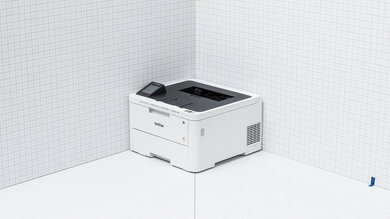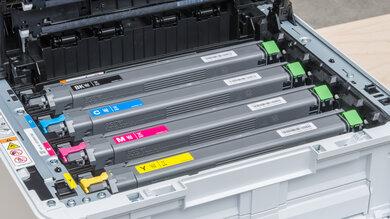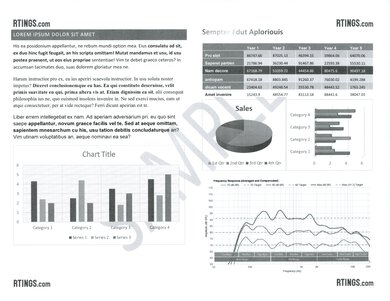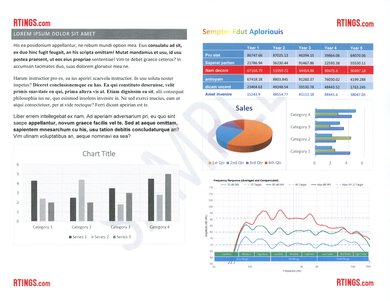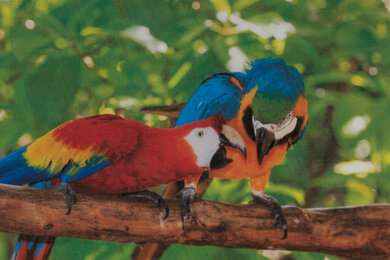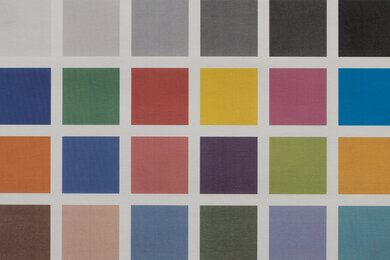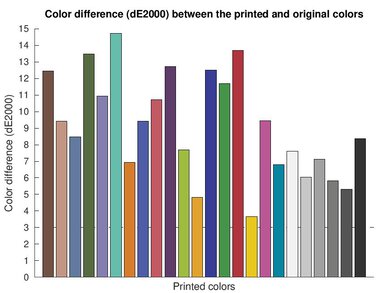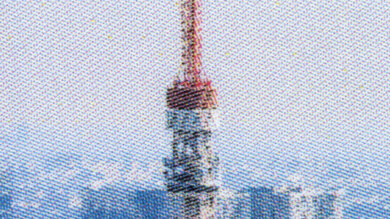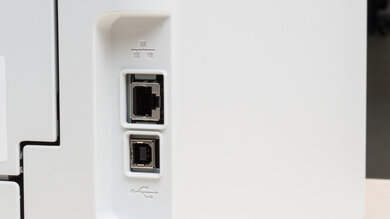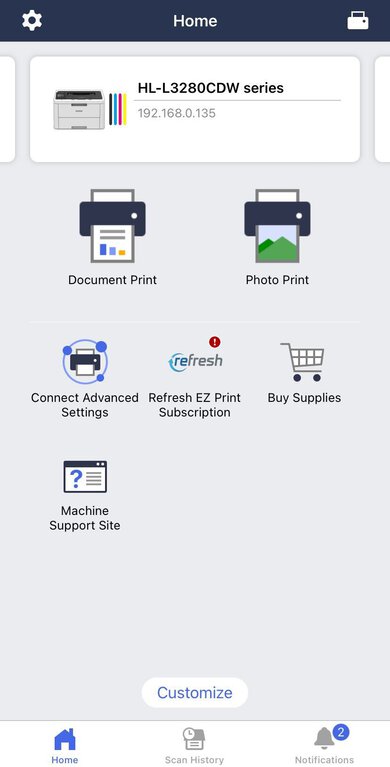The Brother HL-L3280CDW is a print-only color laser printer. It replaces the Brother HL-L3270CDW Laser. This standalone unit uses Brother's TN229 toner cartridges, and it's compatible with the TN229XL high-yield cartridges and eligible to enroll in Brother's Refresh ink/toner subscription service. Connectivity options include USB, Wi-Fi, and Ethernet, and there's support for Apple AirPrint and Mopria Print Service. It has a few variants with slightly different features and performance; you can see them in the Differences Between Variants section.
Our Verdict
The Brother HL-L3280CDW is okay for family use. Its wide variety of connectivity options make it easy for all household members to access, and thanks to its high page yield and relatively inexpensive toner cartridges, it doesn't cost much to maintain over time. It produces very sharp documents and prints quickly; however, it isn't ideal for photo printing because it has a narrow color range, and its printing pattern is clearly visible in printed photos. Also, the lack of a scanner might be a dealbreaker for some.
- Produces incredibly sharp documents.
- Fast printing speeds.
- High page yield, low cost-per-print.
- Wide connectivity options.
- No scanner.
- Not ideal for photo printing due to low print resolution and printing pattern.
- Narrow color range and poor accuracy.
The Brother HL-L3280CDW is a good office printer. It produces incredibly sharp documents, doesn't take long to warm up, and prints quickly at up to 28 pages per minute. It has many connectivity options, including Wi-Fi and Ethernet, making it easy for everyone in the office to access. The regular toner cartridges yield a large number of prints, and you can get XL cartridges that'll last even longer. Replacement toner is relatively cheap, so you won't have to worry about high running costs. Unfortunately, the lack of a scanner might be a dealbreaker for some offices.
- Produces incredibly sharp documents.
- Fast printing speeds.
- High page yield, low cost-per-print.
- Wide connectivity options.
- No scanner.
The Brother HL-L3280CDW is good for student use. It produces amazingly sharp documents, warms up in very little time, and prints quickly at up to 28 pages per minute. Its toner cartridges yield a large number of prints and are relatively inexpensive, so you won't have to worry about high running costs. The main drawback is that it lacks a scanner, which might be inconvenient if you need to scan textbooks or make copies.
- Produces incredibly sharp documents.
- Fast printing speeds.
- High page yield, low cost-per-print.
- Wide connectivity options.
- No scanner.
The Brother HL-L3280CDW is great for printing black-and-white documents. It produces high-quality documents and prints quickly at up to 28 pages per minute. Plus, its toner cartridges yield a large number of prints and are fairly inexpensive, making it cheap to maintain over time. It's a print-only unit, though, so you'll need a separate scanner if you need to scan anything.
- Produces incredibly sharp documents.
- Fast printing speeds.
- High page yield, low cost-per-print.
- No scanner.
The Brother HL-L3280CDW is bad for photo printing. Printed pictures look awful because this model prints at a low resolution and can only produce a narrow range of colors. Also, like most laser printers, the printing pattern is very visible, causing further loss of detail.
- High page yield, low cost-per-print.
- Not ideal for photo printing due to low print resolution and printing pattern.
- Narrow color range and poor accuracy.
- High page yield, low cost-per-print.
- High page yield, low cost-per-print.
- High page yield, low cost-per-print.
- High page yield, low cost-per-print.
- High page yield, low cost-per-print.
Performance Usages
Check Price
Differences Between Sizes And Variants
We tested the Brother HL-L3280CDW. There are a few variants with slightly different features and performance; you can see them in the table below.
| Model | Display | Advert. Print Speed | Connectivity | Paper Input |
|---|---|---|---|---|
| HL-L3220CDW | 1-line monochrome LCD | 19 PPM | Wi-Fi, USB | 1-sheet multi-purpose tray |
| HL-L3240CDW | 1-line monochrome LCD | 27 PPM | Wi-Fi, USB, Ethernet | 1-sheet multi-purpose tray |
| HL-L3280CDW | 2.7-inch Color Touchscreen | 27 PPM | Wi-Fi, USB, Ethernet | 1-sheet multi-purpose tray |
| HL-L3295CDW | 2.7-inch Color Touchscreen | 31 PPM | Wi-Fi, USB, Ethernet, External Storage (USB), NFC | 30-sheet multi-purpose tray, supports optional 250-sheet input tray |
See our unit's label here.
Popular Printer Comparisons
The Brother HL-L3280CDW is a great color laser printer. It stands out for its sturdy build, outstanding print quality, and fast printing speeds. That said, the lack of a scanner might be a dealbreaker for many.
See our recommendations for the best laser printers, the best office printers, and the best printers for small business.
The Brother HL-L2380CDW and the Brother MFC-L3780CDW are very similar regarding print quality and yield; however, the former is a print-only unit, while the latter is an all-in-one with a scanner. The MFC-L3780CDW technically prints black-and-white documents faster, but only when using a wired USB connection, as its printing speed drops considerably when printing over Wi-Fi. The MFC-L3780CDW has more connectivity options, including support for NFC and external storage drives (USB), though you can get a variant of HL-L3280CDW with the same features.
The Brother HL-L3280CDW is a newer version of the Brother HL-L3270CDW Laser. They have identical features and perform similarly in print quality. The HL-L3280CDW prints slightly faster but doesn't yield as many color prints as the older HL-L3270CDW. The biggest difference is that the HL-L3270CDW requires more maintenance because its drum unit wears out much faster.
The Brother HL-L3280CDW and the HP Color LaserJet Pro M255dw are very similar print-only color laser printers. The Brother produces higher-quality documents and prints faster but doesn't yield as many prints as the HP. It's worth noting that the HP uses cartridges with an integrated drum, while the Brother has a separate drum unit. An integrated drum makes maintenance less of a hassle since you don't have to replace the drum separately; however, it's also more wasteful because drums typically last much longer than the toner, and you'd have to discard the entire cartridge if the drum gets damaged.
The Brother HL-L3280CDW and the Xerox VersaLink C500/DN are both print-only color laser printers. The Xerox prints much faster, up to 45 pages per minute, and its input tray can hold a lot of paper, making it a better option for high-volume printing. Although the Xerox printer's toner cartridges cost significantly more than the Brother's, they yield considerably more prints, resulting in a lower cost-per-print. However, the Xerox model's connectivity is more of a hassle because you have to buy the wireless adapter separately to use Wi-Fi.
Test Results

The Brother HL-L3280CDW feels well-built. It has a sturdy all-plastic body, with solid-feeling hinges and tray. The power cord is removable if you need to replace it. Its design gives you easy access to the toner cartridges, sheet rollers, belt unit, and waste toner box for maintenance. The only complaints are minor, like the display being in a fixed position and the lack of a cover to prevent dust and debris from falling into the output tray at the top. There are grooves on the sides so you can get a good grip when carrying the printer; they're quite handy, as the printer is heavy.
Here are the advertised measurements for the other variants:
- HL-L3220CDW/HL-L3240CDW
- Height: 9.4" (23.9 cm)
- Width: 15.7" (39.9 cm)
- Depth: 15.7" (39.9 cm)
- Weight: 33.5 lbs (15.2 kg)
- HL-L3295CDW
- Height: 10.8" (27.4 cm)
- Width: 15.7" (39.9 cm)
- Depth: 17.6" (44.6 cm)
- Weight: 36.8 lbs (16.7 kg)
This printer doesn't need much maintenance. Unlike inkjet printers, there's no risk of clogging if you don't use the printer for a long time. The toner cartridges yield a large number of prints, so you won't need to replace them often unless you print a lot. Replacing the toner cartridges is straightforward—you can access them by lifting the top of the printer. The drum is a separate unit you'll have to replace, but again, it isn't something you’ll have to do regularly, as it has a lifespan of around 20,000 prints. Having a separate drum is also less wasteful and might cost less in the long run, as, unlike cartridges with an integrated drum, you don't have to throw out the whole cartridge if the drum gets damaged. Also, drums usually last much longer than the toner. At the time of writing, we could only find the drum unit sold in a pack of four, whereas the toner cartridges are available individually. Other parts that will eventually need replacing are the waste toner box (to collect excess toner produced during printing) and the belt unit; both have an estimated lifespan of about 50,000 prints and are widely available through Brother, marketplaces, and third-party sellers. The belt unit is below the toner cartridges, and the waste toner box is below the belt.
For paper jams, you can access the sheet rollers via a panel on the back of the printer or by removing the paper tray. The input tray holds 250 sheets of paper; if you want a bigger input tray capacity to minimize maintenance, you can get the top-end Brother HL-L3295CDW variant, which supports an additional 250-sheet tray (sold separately), bringing the total capacity to 500 sheets.
See the user guide here.
The display is reasonably large, and its wide viewing angles make it easy to see whether you're sitting, standing, or off to the side. The lack of tilt and swivel adjustment doesn't affect its usability. Touch input feels responsive, and the interface is user-friendly. The screen's finish picks up a lot of fingerprints, though, which might bother some people.
The HL-L3295CDW variant has the same display, while the HL-L3220CDW and HL-L3240CDW variants have a 1-line monochrome LCD.
The regular TN229 toner cartridges yield a large number of prints and won't need regular replacement unless you print a lot. You can get high-yield cartridges; the TN229XL cartridges have an estimated yield of 3,000 black and 2,300 color prints, while the TN229V Value High-yield toner gets you around 3,300 black and 2,530 color prints. There are Super High-Yield cartridges (TN229XXL), which have an estimated yield of 4,500 black and 4,000 color prints; however, they only work with the top-end Brother HL-L3295CDW variant. The starter cartridges that come with the printer have an approximate yield of 1,000 black and 1,000 color prints.
The printer warns you when the toner is low; clicking on the message shows you which cartridge is running out, along with an ad for Brother's ink/toner subscription service. It stops printing entirely when a cartridge is empty and shows you a 'Replace Toner' message followed by instructions on replacing the cartridges.
This is a print-only unit.
The cost-per-print is great, as the toner cartridges aren't overly expensive and yield a large number of prints. You'll have to spend extra to replace the drums; however, they don't need regular replacement, as they have an estimated lifespan of 20,000 prints.
The print speed varies depending on the model. Here are the advertised print speeds (black and color) for the other variants:
- HL-L3220CDW: 19 PPM
- HL-L3240CDW: 27 PPM (same as this model)
- HL-L3295CDW: 31 PPM
The output tray holds 150 prints; this is the same for all variants. All models have a single-sheet multi-purpose tray except for the top-end Brother HL-L3295CDW variant, which has an increased capacity of 30 sheets. The HL-L3295CDW also supports an additional 250-sheet input tray (sold separately).
Prints come out slightly curled and remain so after they've cooled. If this bothers you, there's a 'Reduce Paper Curl' setting that can help. The posted max paper weight applies to the main input tray and the manual feeder.
The main input tray takes plain (thin or thick) and recycled paper. The multi-purpose tray takes plain paper, recycled paper, bond, envelopes, and glossy paper.
Brother specifies in the manual that this printer can print on glossy paper (NewPage Futura Laser Gloss 80 lb Text paper suggested); however, we couldn't find any at the time of writing. As such, we consider the printer incapable of printing on glossy paper.
The Brother HL-L3220CDW variant doesn't have an Ethernet port. The Brother HL-L3295CDW variant supports NFC (Near-Field Communication), allowing you to connect an NFC-enabled device by tapping it against the printer, and it can also print directly off a USB flash drive.
Brother's Mobile Connect app is superb. It lets you print, order supplies, manage your toner/ink subscription, access the printer's support page, and perform maintenance tasks. You can print even when you aren't home or close to the printer, though this function requires a Brother account. This app can't print webpages directly, so you'll have to print them from whichever app or browser you use to view them.
Installing drivers or apps on Chrome OS and macOS devices is unnecessary. You don't necessarily need to do it on Windows devices to print, but we recommend doing so, as it'll ensure you get access to all the settings and functions. You can get the drivers here.


